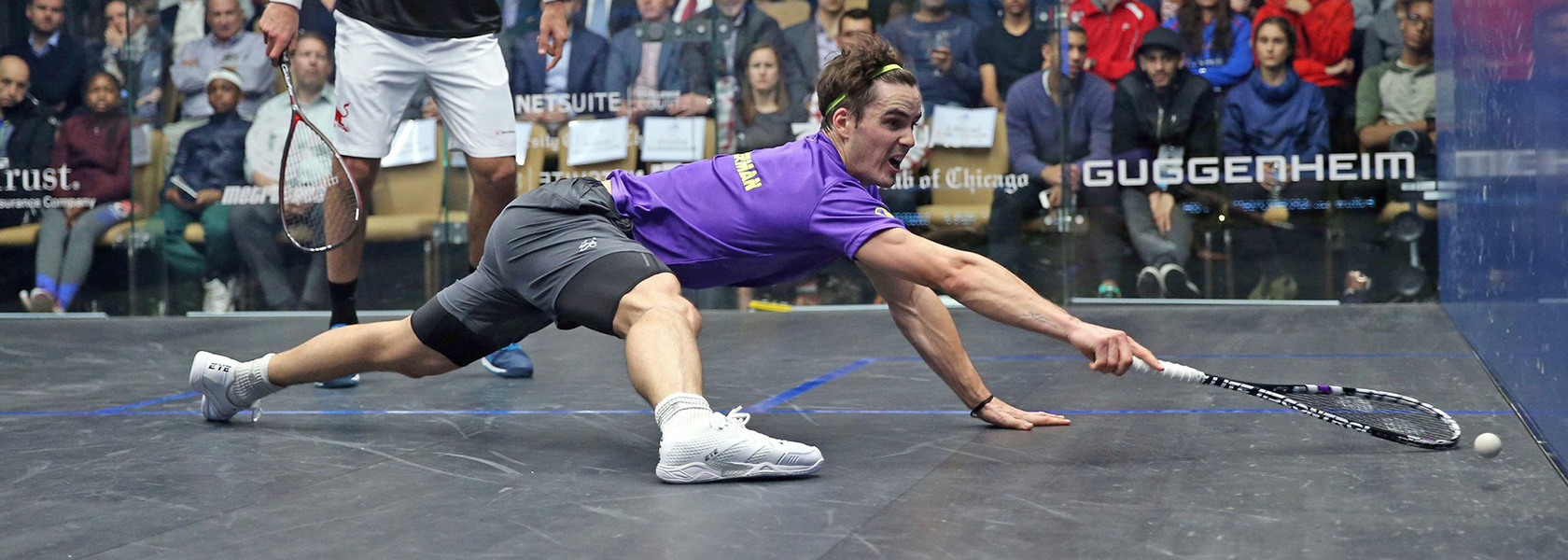Malcolm Willstrop – Accuracy
We asked Malcolm Willstrop what the single most important attribute was in order to become a successful squash player. His answer… Accuracy.
The Practice Environment
The entire purpose of practice is to get better and there are different ways to achieve that, depending on how much better you want to get. Not everybody wants to be a professional and take their sport incredibly seriously and their practice will be a reflection of that. Some will have a desire to improve and be willing to push themselves in order to achieve the improvement that they seek. A very small percentage of people will want to be professionals, so their practice needs to prepare them for the demands of professional squash.
Malcolm Willstrop on Amr Shabana
I first saw Amr Shabana at the World Junior Championships in Cairo in 1996, where Lee Beachill, Stewart Boswell and Anthony Ricketts were also competing and Shabs had the reputation of being a shotmaker without serious intent.
Flow like the French!
We’re delighted to welcome Camille Serme to SquashSkills, as she takes us through her approach to the game technically, tactically, physically, and mentally – all of the 4 crucial components of the competitive squash player.
Five things that make Ali Farag a great squash player
Here are five reasons why Ali Farag has risen to the top of the men’s game since graduating from Harvard University.
Decision making in squash
Elite performers in sports such as squash are often lauded for their ability to play the right shot at the right time. While what is deemed the ‘correct’ shot may differ from player to player or coach to coach, it is certainly a key indicator of high level players that they have good decision making skills, that consistently result in a successful outcome. For those trying to improve their squash the ability to improve their decision making is thus an important factor, yet many players find it a difficult area of their game to consciously develop.
How mental fatigue can affect your squash performance
Squash is a tough enough sport as it is, never mind when your evening game/training session has been preceded by a long day at the office.
Just about every player at every level will have at one time or another blamed a loss on work/social/family stresses while lamenting their poor performance, but is there any actual real evidence to support the validity of this oft-used ‘excuse’?
Flexibility for squash – part 1
When most people think ‘Flexibility’, they think ‘Stretching’. The idea that making the muscles ‘longer and looser’ is an essential part of warming-up, cooling down, and enhancing performance for a sport such as squash is one of those ideas that is pretty entrenched in most players minds.
My SquashSkills experience – David Taylor
I write to you from Leme Tênis Clube in Rio de Janeiro, Brazil, which was founded in 1914 and for many years was prominent in Rio de Janeiro for the level of its squash, as well as tennis.
My SquashSkills experience – Garry Irwin
It’s a pleasure to write this endorsement for SquashSkills. In September 2014, I had a major hip replacement which had been affecting my squash ability. I did not rush back into competitive play for 18 months after the operation.
Limited space training for squash players
Squash is a sport that requires a high level of physical conditioning to excel. Players serious about their squash spend a lot of time and effort on their training programmes, working hard to squeeze in all of their sessions each week. It can thus be frustrating when workouts have to be moved or missed when work/family/social commitments intrude, and confine time and space availability.
Your 5-point squash pre-season checklist!
We’ve already been treated to some outstanding early season matches on the PSA tour in China, France, and Hong Kong. With Autumn creeping in it’s now the turn of dedicated club players up and down the country to start getting back into the swing of things, as club box leagues and county league team squash begin kicking into gear for the new season.
To make sure you’re prepped for the coming season and ready to hit the ground running, check out our 5 point pre-season checklist:
Technical vs Outcome driven sessions
As a player, I was driven first and foremost about the outcome of a shot and by extension, the rally. As a coach, I have to stop myself getting too caught up in the technical aspects of the game and allow the players I teach to find ways to achieve the desired outcome without too much technical coaching. Obviously, there needs to be some consistency in form and the mechanics have to be correct for the shot to be accurate. However, there as so many ways to reach the same impact point that too much technical focus can be counterproductive.
What the science says: Effects of carb ingestion on skill maintenance in squash players
In this new semi-regular feature, we’ll be investigating some of the scientific studies that have been done into squash to see ‘what the science says’.
Searching through the academic journal databases for research studies performed into major mainstream sports such as football, rugby, and tennis, yields thousands upon thousands of results.
Perhaps unsurprisingly, squash’s much lower profile means there haven’t been anywhere near as many scientific trials centred upon the sport over the years. There is however a relatively small but solid amount of squash based studies available out there with a bit of searching, and I’ll be picking one out from time to time to examine in these blog posts to reveal the experimenters’ findings.
Is caffeine an effective performance enhancer for the squash player?
Although most people are familiar with caffeine and are aware of some of its potential benefits and effects, there are still a lot of myths and misconceptions as to its exact uses and functions within the body. Used correctly though, it can be a very useful performance enhancer for the squash player.
How you can get the best out of your team
There is a certain level of complexity involved with team dynamics in any sport as there are many factors such as personalities, cultures, ages and abilities amongst the set of players. In squash, the team aspect is rather unique. Usually, your team consists of 5,7 or 9 players and you set your lineup after try-outs, challenge matches or rankings.
Are ankle weights beneficial for the squash player?
We get a ton of great feedback and questions sent in to us here at SquashSkills, many that well warrant a wider audience. In a new periodical feature on the blog, we’re going to be expanding on some of these discussions and making them into full articles.
This week’s then, sees us addressing a recent question that came in from a member about the use of ankle weights for the squash player:
“I was wondering if you have any advice on utilising ankle weights while playing/training? I have heard that some Egyptian players do this?”
What made David Palmer the player he was
Heading to Florida, I was really intrigued to hear what made David the player he was. This was going to be the first time after years of fierce competition I would get the chance to hear how and what David worked on and could properly understand how he ticked, and after all this time, I was fascinated. I imagined an incredibly hard worker with attention to detail being paramount, with a constant desire to get better. Not that difficult to deduce considering David’s style of play and hugely successful career, but I was more impressed than I thought I’d be with just how focused he was throughout his career.
Fitness programme update – Get stronger
We’ve got a great selection of training programmes now live on the site, with more being added periodically.
Whether you’re looking to focus on your speed, your endurance, or if you’re just looking for a general all-round physical boost, there’s a programme for you.



















